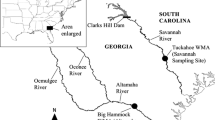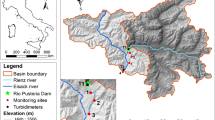Summary
Recovery following hydrological disturbances is usually rapid for lotic invertebrates. Stream ecologists have assumed that recovery is facilitated by behavioral migrations during floods down into the hyporheic zone (the interstitial spaces of a streambed) to seek temporary refuge from possible erosion (the “hyporheic refuge hypothesis”). We provide the first explicit test of this hypothesis by evaluating three predictions of the hypothesis. We coupled field observations of the response of meiofaunal invertebrates to floods with field and flume experiments. The study site was a sandy-bottom stream in northern Virginia. Prediction 1, that loss of fauna from a streambed during floods should be minimal as long as the depth of scour in the streambed is less than the depth of the hyporheic zone, was not supported for any taxon. For two floods which varied considerably in magnitude, 50–90% of the fauna was lost from the bed despite the fact that the depth of scour (10–30 cm) was significantly less than the total depth of the hyporheic zone (50 cm). Prediction 2, that fauna should move deeper into the bed at higher flows, was supported by field observations during only one of two floods and then only for rotifers. In flume experiments that tested for finer scale behavioral movements, significant vertical migrations were found for copepods and chironomids which moved 1.5–3.5 cm downward as mean velocity (3 cm off bottom) was increased from 5–23 cm/s. Movements down by rotifers were not found in the flume experiments. Prediction 3, that the hyporheic zone is the most important source of colonists to defaunated areas, was supported in part by field experiments. The hyporheic route was not the primary route for any taxon but it was as important for the rotifers and copepods as water column or streambed surface routes. We conclude that, even though smallscale (cm's) migrations into the streambed in response to increased flow may be observed for some taxa and the hyporheic zone may serve as a partial source of colonists following disturbances, movements down are not adequate in preventing significant losses of meiofauna during floods.
Similar content being viewed by others
References
Abrahamson WG, Caswell H (1982) On the comparative allocation of biomass, energy, and nutrients in plants. Ecology 63:982–991
Bell SS, Sherman KS (1980) Tidal resuspension as a mechanism for meiofauna dispersal. Mar Ecol Prog Ser 3:245–249
Bilby RE (1981) Role of organic debris dams in regulating the export of dissolved and particulate matter from a forested watershed. Ecology 62:1234–1243
Bishop JE (1973) Observations on the vertical distribution of the benthos in a Malaysian stream. Freshw Biol 3:147–156
Butman CA (1986) Sediment trap biases in turbulent flows: results from a laboratory flume study. J Mar Res 44:645–693
Chandler GT, Fleeger JW (1983) Meiofaunal colonization of azoic estuarine sediments in Louisiana: mechanisms of dispersal. J Exp Mar Biol Ecol 69:175–188
Connell JH, Sousa WP (1983) On the evidence needed to judge ecological stability or persistence Am Nat 121:789–824
Cushing CE, Gaines WL (1989) Thoughts on recolonization of endorheic cold desert spring streams. J N Am Benthol Soc 8:277–287
D'Amours D (1988) Vertical distribution and abundance of natant harpacticoid copepods on a vegetated tidal flat. Neth J Sea Res 22:161–170
Delucchi CM (1989) Movement patterns of invertebrates in temporary and permanent streams. Oecologia 78:199–207
Denny MW (1988) Biology and the wave-swept environment. Princeton Univ Press Princeton 325 pp
Fegley SR (1987) Experimental variation of near-bottom current speeds and its effects on depth distribution of sand-living meiofauna. Mar Biol 95:183–191
Fegley SR (1988) A comparison of meiofaunal settlement onto the sediment surface and recolonization of defaunated sandy sediment. J Exp mar Biol Ecol 123:97–113
Fisher SG (1983) Succession in streams. In: Barnes JR, Minshall GW (eds) Stream Ecology: Application & Testing of General Ecological Theory. Plenum Press, NY, pp 7–27
Fisher SG (1990) Recovery processes in lotic ecosystems: limits of successinal theory. Environ Managem 14:725–736
Giller PS, Cambell RNB (1989) Colonisation patterns of mayfly nymphs (Ephemeroptera) on implanted substrate trays of different size. Hydrobiologia 178:59–71
Goldstein RJ (1983) Fluid mechanics measurements. Hemisphere Publ Co, NY, 630 pp
Gray LJ, Fisher SG (1981) Post flood recolonization pathways of macroinvertebrates in a lowland Sonoran desert stream. Am Midl Natur 106:249–257
Hagerman GM, Rieger RM (1981) Dispersal of benthic meiofauna by wave and current action in Bogue Sound, North Carolina, U.S.A. Mar Ecol Publ Staz Napoli 2:245–270
Heip C (1972) Reproductive potential of copepods in brackish water. Mar Biol 12:219–221
Hildrew AG, Dobson MK, Groom A, Ibbotson A, Lancaster J, Rundle SD (1990) Flow and retention in the ecology of stream invertebrates. Verh Internat Verein Limnol
Howard RK (1985) Measurements of short-term turnover of epifauna within seagrass beds using an in situ staining method. Mar Ecol Prog Ser 22:163–168
Juget J, Goubier V, Barthelemy D (1989) Intrinsic and extrinsic variables controlling the productivity of asexual populations of Nais spp. Hydrobiologia 180:177–184
Kirk RE (1982) Experimental design: procedures for the behavioral sciences. 2nd edn. Brooks/Cole Publ Co, London
Lefkovitch LP, Fahrig L (1985) Spatial characteristics of habitat patches and population survival. Ecol Model 30:297–308
Leopold L, Wolman MG, Miller JR (1964) Fluvial processes in geomorphology. Freeman Press, San Francisco
Lochhead G, Learner MA (1983) The effect of temperature on the asexual population growth of three species of Naididae. Hydrobiologia 98:107–112
Marchant R (1988) Vertical distribution of benthic invertebrates in the bed of the Thomson River, Victoria. Aust J Mar Freshw Res 39:775–784
Marmonier R, Creuze des Chatelliers M (1991) Effects of spates on interstitial assemblages of the Rhone River: importance of spatial heterogeneity. Hydrobiologia 210:243–251
McElhone MJ (1978) A population study of littoral dwelling Naididae (Oligochaeta) in a shallow mesotrophic lake in North Wales. J Anim Ecol 47:615–626
Menge BA, Sutherland JP (1987) Community regulation: variation in disturbance, competition, and predation in relation to environmental stress and recruitment. Am Natur 130:730–757
Metzler GM, Smock LA (1990) Storage and dynamics of detritus in a sand-bottomed stream. Can J Fish Aq Sci 47:588–594
Minshall GW, Andrews DA, Manuel-Faler CY (1983) Application of island biogeographic theory to streams: macroinvertebrate recolonization of the Teton River, Idaho. In: Barnes JR, Minshall GW (eds) Stream Ecology: application and testing of general ecological theory Plenum Press, New York pp 279–297
Minshall GW, Cummins KW, Peterson RC, Cushing CE, Bruns DA, Sedell JR, Vannote RL (1985) Developments in stream ecosystem theory. Can J Fish Aquatic Sci 42:1045–1055
Naiman RJ (1982) Characteristics of sediment & organic carbon export from pristine boreal forest watersheds. Can J Fish Aquatic Sci 39:1699–1718
O'Doherty EC (1985) Stream-dwelling copepods: their life history and ecological significance. Limnol Oceanogr 30:554–564
O'Doherty EC (1988) The ecology of meiofauna in an Appalachian head-water stream. Ph. D. disseration. Univ. Georgia. 113 pp
Okubo A (1984) Critical patch size for plankton and patchiness. In: Levin SA, Hallam TG (eds) Mathematical Ecology. Lecture notes in Biomathematics, vol 54, Springer Berlin, pp 456–477
Paine R (1966) Food web complexity and species diversity. Am Nat 100:65–75
Palmer MA (1988a) Dispersal of marine meiofauna: a review and conceptual model explaining passive transport and active emergence with implications for recruitment. Mar Ecol Prog Ser 48:81–91
Palmer MA (1988b) Marine meiofauna and epibenthic predators: separating predation, disturbance, and hydrodynamic effects. Ecology 69:1251–1259
Palmer MA (1990a) Temporal and spatial dynamics of meiofauna within the hyporheic zone of Goose Creek, Virginia. J N Am Benthol Soc 9:17–25
Palmer MA (1990b) Understanding the movement dynamics of a stream-dwelling meiofauna community using marine analogs. Stygologia 5:67–74
Palmer MA (1992) Incorporating lotic meiofauna into our understanding of faunal transport dynamics. Limno. Oceanogr.
Palmer MA, Gust G (1985) Dispersal of meiofauna in a turbulent tidal creek. J Mar Res 43:179–210
Palmer MA, Molloy RM (1986) Flow and the vertical distribution of meiofauna: a flume experiment. Estuaries 9:225–228
Pickett STA, White PS (1985) The ecology of natural disturbance and patch dynamics. Academic Press, Inc. Orlando. 427 pp
Poff NL, Ward JV (1990) Physical habitat template of lotic systems: recovery in the context of historical pattern of spatiotemporal heterogeneity. Environ Managem 14:629–645
Poole WL, Stewart KW (1976) The vertical distribution of macrobenthos within the substratum of the Brazos River, Texas. Hydrobiologia 50:151–160
Power ME, Stewart AJ (1987) Disturbance and recovery of an algal assemblage following flooding in an Oklahoma stream. Am Midl Natur 177:333–345
Pringle CM, Naiman RJ, Bretschko G, Karr JR, Oswood MW, Webster JR, Welcomme RL, Winterbourn RL (1988) Patch dynamics in lotic systems: the stream as a mosiac. J N Am Benthol Soc 7:503–524
Reice SR (1985) Experimental disturbance and the maintenance of species diversity in a stream community. Oecologia 67:90–97
Reice SR, Wissmar RC, Naiman RJ (1990) Disturbance regimes, resilience, & recovery of animal communities & habitats in lotic ecosystems. Environm Managem 14:647–659
Resh VH, Brown AV, Covich AP, Gurtz ME, Li HW, Minshall GW, Reice SR, Sheldon AL, Wallace JB, Wissman RC (1988). The role of disturbance in stream ecology. J N Am Benthol Soc 7:433–455
Rhoads DC, Aller RC, Goldhaber MB (1977) The influence of colonizing benthos on physical properties and chemical diagenesis of the estuarine seafloor. In: Coull BC (ed) Ecol Marine Benthos. Univ SC Press, Columbia, pp 113–138
Rhoads DC, Yingst JY, Ullman WJ (1978) Seafloor stability in Central Long Island Sound. Part I. Temporal changes in erodibility of find-grained sediment. In: Wiley ML (ed) Estuarine Interactions. Academic Press, New York, pp 221–242
SAS Institute, Inc (1985) Sas User's Guide: Statistics. Version 5 Edn. Sas Institute Inc., Cary
Schlichting H (1979) Boundary Layer Theory. 7th edn, McGraw-Hill, New York
Sedell JR, Reeves GH, Hauer FR, Stanford JA, Hawkins CP (1990) Role of refugia in recovery from disturbances: modern fragmented and disconnected river systems. Environ Manage 14:711–724
Sherman KS, Coull BC (1980) The response of meiofauna to sediment disturbance. J Exp mar Biol Ecol 46:59–71
Sleath JFA (1984) Sea Bed Mechanics. John Wiley & Sons, New York, 335 pp
Sousa WP (1984) The role of disturbance in natural communities. Ann Rev Ecol Syst 15:353–391
Townsend CR, Hildrew AG (1976) Field experiments on the drifting, colonisation and continuous redistribution of stream benthos. J Anim Ecol 45:759–773
Wallace JB (1990) Recovery of lotic macroinvertebrate communities from disturbance. Environm Managem 14:605–620
Walters K, Bell SS (1986) Diel patterns of active vertical migration in seagrass meiofauna. Mar Ecol Prog Ser 34:95–103
Ward JV, Voelz NJ (1990) Gradient analysis of interstitial meiofauna along a longitudinal stream profile. Stygologia 5:93–99
Williams DD (1984) The hyporheic zone as a habitat for aquatic insects and associated arthropods. In: Resh VH, Rosenberg DM (eds). The Ecology of Aquatic Insects. Praeger, New York, pp 430–455
Williams DD, Hynes HBN (1974) The occurrence of benthos deep in the substratum of a stream. Freshw Biol 4:233–256
Winkler G Debris dams and retention in a low order stream. Verh Limnol 24:
Author information
Authors and Affiliations
Rights and permissions
About this article
Cite this article
Palmer, M.A., Bely, A.E. & Berg, K.E. Response of invertebrates to lotic disturbance: a test of the hyporheic refuge hypothesis. Oecologia 89, 182–194 (1992). https://doi.org/10.1007/BF00317217
Received:
Accepted:
Issue Date:
DOI: https://doi.org/10.1007/BF00317217




